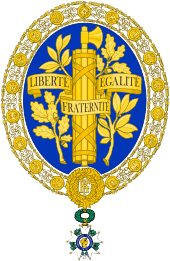
Back Gesetz zur Trennung von Kirche und Staat (Frankreich) German Leĝo malkuniganta eklezion kaj ŝtaton EO Ley francesa de separación de la Iglesia y el Estado de 1905 Spanish Loi de séparation des Églises et de l'État French Legge di separazione tra Stato e Chiese del 1905 Italian 政教分離法 Japanese Wet op de scheiding van kerk en staat Dutch Ustawa o rozdziale Kościoła od państwa we Francji z 1905 roku Polish Lei francesa sobre a separação das Igrejas e do Estado (1905) Portuguese Закон о разделении церквей и государства (Франция) Russian
| Law on the Separation of Church and State | |
|---|---|
 | |
| Legislative Chambers of the French Third Republic | |
| |
| Territorial extent | France, except in: |
| Passed by | Chamber of Deputies |
| Passed | 3 July 1905 |
| Passed by | Senate |
| Passed | 6 December 1905 |
| Signed by | President Émile Loubet |
| Signed | 9 December 1905 |
| Commenced | 1 January 1906 |
| Legislative history | |
| First chamber: Chamber of Deputies | |
| Introduced by | Aristide Briand (SI) Émile Combes (PRRRS) Jean Jaurès (SFIO) Francis de Pressensé (SFIO) |
| Passed | 3 July 1905 |
| Second chamber: Senate | |
| Passed | 6 December 1905 |
| Keywords | |
| Separation of Church and State Freedom of religion Freedom of expression | |
| Status: Current legislation | |
The 1905 French law on the Separation of the Churches and State (French: Loi du 9 décembre 1905 concernant la séparation des Églises et de l'État) was passed by the Chamber of Deputies on 3 July 1905. Enacted during the Third Republic, it established state secularism in France. France was then governed by the Bloc des gauches (Left Coalition) led by Émile Combes. The law was based on three principles: the neutrality of the state, the freedom of religious exercise, and public powers related to the church. This law is seen as the backbone of the French principle of laïcité (secularism). It is however not applicable in Alsace and Moselle, which were part of Germany when it was enacted.